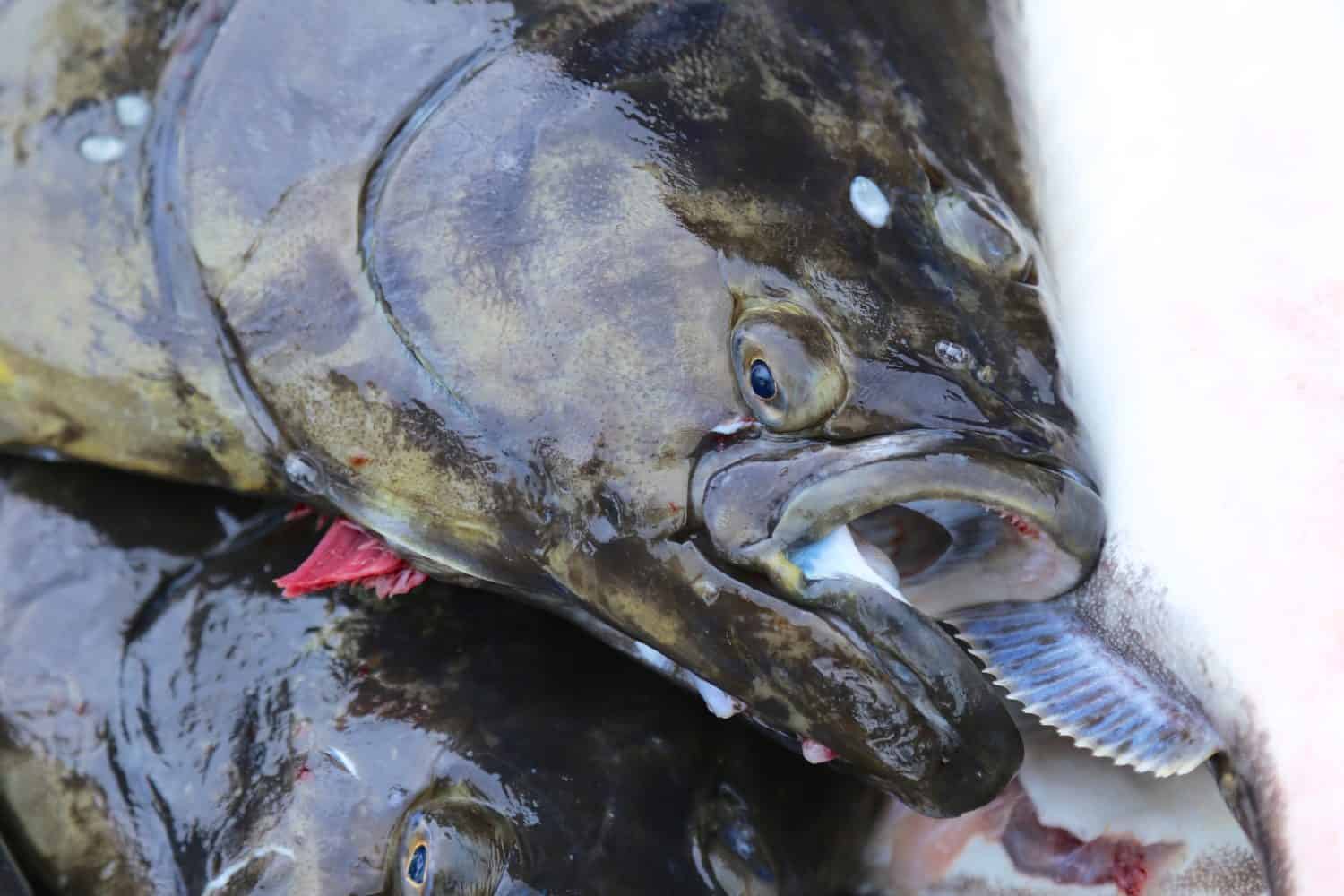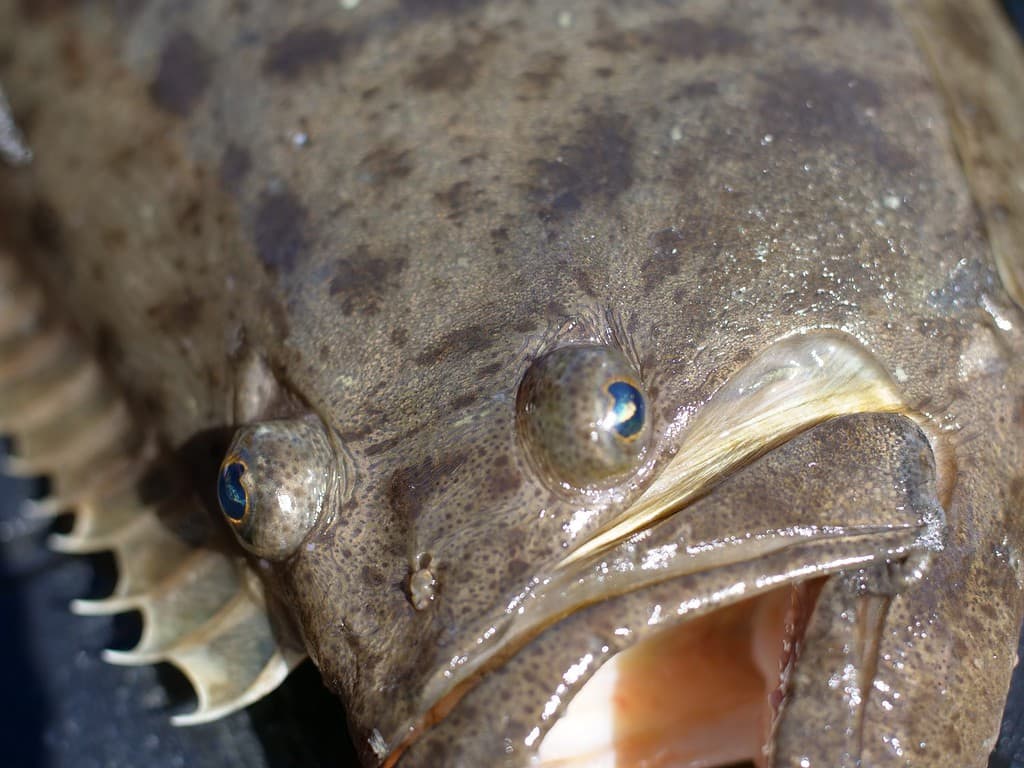The fishing scene in British Columbia offers over 20,000 lakes to venture into. Sharing a coast with the Pacific Ocean, local anglers have a chance to catch multiple varieties of salmon, flatfish, and more. With the proper licensing, most people find their good fortune in rainbow trout, the most common fish in British Columbia. With their northern and western coasts offering some of the best halibut fishing in Canada, the only challenge is reeling it in. Let’s take a look at the largest halibut ever caught in British Columbia, learning a little more about the Pacific halibut.
Record of Largest Pacific Halibut Caught in British Columbia
With no official fishing records in British Columbia, several officials keep their own records of large catches, but the consensus is mixed.
©CSNafzger/Shutterstock.com
While British Columbia offers few substantial catches along its shores, the man who managed to secure the largest halibut in British Columbia was Walter Zimber. Caught in 1955, none of the catches exceeded the 482 pounds of this massive Pacific halibut. Zimber spent 4 painstaking hours to bring it in with his handline. However, the IGFA has not recorded any of these catches officially.
A now-closed fishing tugboat company called Westwind Tugboat Adventures claims that they also set a local record. With a group of fishermen near Langara Island, two lifelong friends set out to find a trophy halibut. However, the fish couldn’t make it into the boat, so they brought it back to shore to weigh it. The overall weight was 320 pounds, making it the local record for the largest halibut caught in British Columbia by rod and reel. Officially, this catch isn’t recorded as a record-breaker.
The only Pacific halibut listed on the official IGFA website was caught in 1992 by Glen Oliver. The Pacific halibut weighed 172 pounds and was caught in Langara Island as well.
World Record for Pacific Halibut
The largest Pacific halibut recorded by the International Game Fish Association was 459 pounds, courtesy of Jack Tragis. When Tragis went fishing off Alaska’s coast in 1996, he managed to secure this fish on a 130-pound line, setting another record for the method of catching the fish.
Over the years, larger halibut were caught by many commercial fishermen, exceeding 500 pounds. However, the IGFA only recognizes these catches through sport-fishing, not commercial methods.
All About Halibut: Average Size and Notable Characteristics
The largest flatfish in the world is the Atlantic halibut, which weighs up to 150 pounds on average.
©Philosophy D/Shutterstock.com
A halibut is easy to spot because it is a flatfish, much like a flounder. The Atlantic halibut is the largest variation with both eyes on one side of the head. The side with the eyes is the upper portion, which is dark brown or gray. The underside of the fish without eyes is white. Their scales are hard to see, but their shape is distinctive enough to identify quickly. When they are first born, their body is symmetrical, but their maturing leads to asymmetrical eye placement.
Typical Distribution of Halibut
Halibut commonly live in the Pacific Ocean, Atlantic Ocean, and the North Sea, preferring deep waters.
©Jon C. Beverly/Shutterstock.com
When you fish in British Columbia, your best odds of a good catch is along the north coast, keeping west of Vancouver Island. Several charters are available to bring you to better spots near Barkley Sound or Tofino. Port Hardy is one of the best spots to set off towards the northern coast. Taking a charter or a personal boat gets you closer to the bottom-dwelling flatfish.
Fishing for Halibut
Since these fish are diurnal, your best odds of catching one are during daylight. Canada and the United States often use long-line fishing, supporting the ongoing commercial halibut fishery since the 1800s. With long-line fishing, circle hooks attach to a weighted line. The line often uses octopus and similar bait to catch their attention amongst the sediment on the sea floor. Common methods of fishing halibut include jigging, drift fishing, and trolling, but opting for fresh bait gives you the best odds.
Since halibut has a slow rate of maturation, some experts think that international efforts to manage the halibut population could be essential to their population. These fish take 8 years to reproduce, so some regulations exist to protect them in British Columbia and the rest of Canada. For a short time, regulators designated a derby-style fishing season so fishermen could race to catch as many as they could. Since regulators decided on the fishing days with no regard for weather, safety issues arose. It also limited fresh halibut supply to the local markets.

Other Record-Breaking Fish Caught in British Columbia
Officially, British Columbia doesn’t have a record of the sizeable fish caught in the area. Instead, several local publications and experts retain these records. Here are some of the records of other substantial fish in British Columbia.
The 890-Pound Sturgeon of Fraser River
Fraser River made history in 2021 when the Vancouver Sun reported that former National Hockey League goalie Pete Peeters set a major record for sturgeon. While fishing with a guide and several friends, the expedition resulted in catching the largest recorded surgeon. At 11.5 feet long and 55 inches around, they estimated a weight of 890 pounds.
The river was in the local news again the following year when CTV News reported that a group caught a sturgeon that was over 10 feet long and just under 700 pounds. It is the largest sturgeon for that particular area along the river, following a 2-hour fight to catch it while going upstream.
The 37-Pound Giant Steelhead of Kispiox River
Steelhead is one of the larger fish species of the Kispiox River, and Clay Carter managed to set the local record. In 1985, Carter went fishing and managed to beach a 37-pound steelhead. Letting it go shortly after, this record surpassed a record for a 34-pound catch a few years before.
The 11.9-Pound Kokanee Salmon of Okanagan Lake
According to the World Record Academy, the largest kokanee salmon ever caught in British Columbia was almost 12 pounds. The previous record was held by Ron Campbell in 2010 at about 8.5 pounds.While this weight for a kokanee salmon is notable, Denis Woodcox didn’t realize what he’d caught at the time. Instead, he said that he thought it was a large rainbow trout resulting in smoking, eating, and sharing it with neighbors before he ever knew what he had.




